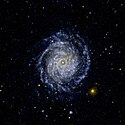NGC 3344
| Galaxie NGC 3344 | |
|---|---|
 | |
| Aufgenommen mit dem 81-cm-Spiegelteleskop des Mount-Lemmon-Observatoriums | |
| AladinLite | |
| Sternbild | Kleiner Löwe |
| Position Äquinoktium: J2000.0, Epoche: J2000.0 | |
| Rektaszension | 10h 43m 31,1s[1] |
| Deklination | +24° 55′ 20″[1] |
| Erscheinungsbild | |
| Morphologischer Typ | (R)SAB(r)bc / HII[1] |
| Helligkeit (visuell) | 9,7 mag[2] |
| Helligkeit (B-Band) | 10,5 mag[2] |
| Winkelausdehnung | 7,1′ × 6,5′[2] |
| Positionswinkel | 18°[2] |
| Flächenhelligkeit | 13,7 mag/arcmin²[2] |
| Physikalische Daten | |
| Zugehörigkeit | isoliert[1] |
| Rotverschiebung | 0.001935 ± 0.000003[1] |
| Radialgeschwindigkeit | (580 ± 1) km/s[1] |
| Hubbledistanz vrad / H0 | (24 ± 2) · 106 Lj (7,21 ± 0,51) Mpc [1] |
| Durchmesser | 30.000 Lj |
| Geschichte | |
| Entdeckung | Wilhelm Herschel |
| Entdeckungsdatum | 6. April 1785 |
| Katalogbezeichnungen | |
| NGC 3344 • UGC 5840 • PGC 31968 • CGCG 124-060 • MCG +04-25-046 • IRAS 10407+2511 • 2MASX J10433114+2455199 • GC 2178 • H I 81 • h 739 • HIPASS J1043+24 • LDCE 743 NED006 • KIG 435 | |
NGC 3344 ist eine Balken-Spiralgalaxie mit ausgedehnten Sternentstehungsgebieten vom Hubble-Typ SBbc im Sternbild Kleiner Löwe am Nordsternhimmel. Sie ist schätzungsweise 24 Millionen Lichtjahre von der Milchstraße entfernt und hat einen Durchmesser von etwa 55.000 Lj. Die Galaxie hat eine Winkelausdehnung von 7,2 × 6,9 Bogenminuten und eine scheinbare Helligkeit von 9,7 mag.
Die Typ-Ic-Supernova SN 2012fh wurde hier beobachtet.[3]
Das Objekt wurde am 6. April 1785 vom deutsch-britischen Astronomen Wilhelm Herschel entdeckt.[4]
- (c) ESA/Hubble, CC BY 4.0
Hochaufgelöste Aufnahme des Hubble-Weltraumteleskops von dem zentralen Bereich
Weblinks
- astronews.com: Spiralgalaxie im Kleinen Löwen 16. Februar 2018
- SIMBAD Astronomical Database
- GoBlack
- Galaxy in a spin (engl.)
Einzelnachweise
Auf dieser Seite verwendete Medien
(c) ESA/Hubble, CC BY 4.0
This image of the spiral galaxy NGC 3344, located about 20 million light-years from Earth, is a composite of images taken through seven different filters. They cover wavelengths from the ultraviolet to the optical and the near-infrared. Together they create a detailed picture of the galaxy and allow astronomers to study many different aspects of it.
Ultraviolet image of the large face on spiral galaxy NGC 3344. The inner spiral arms are wrapped so tightly that they are difficult to distinguish.
Autor/Urheber: Torsten Bronger, Lizenz: CC-BY-SA-3.0
This is a celestial map of the constellation Leo Minor, the Small Lion.
Autor/Urheber: Credit Line and Copyright Adam Block/Mount Lemmon SkyCenter/University of Arizona, Lizenz: CC BY-SA 3.0 us
NGC 3344
Picture Details:
Optics 32-inch Schulman Telescope (RC Optical Systems), Acquired remotely
Camera SBIG STX 16803 CCD Camera
Filters AstroDon Gen II
Dates March 2013
Location Mount Lemmon SkyCenter
Exposure LRGB = 5.5:2:2:2 hours
Acquisition ACP Observatory Control Software (DC-3 Dreams),TheSky (Software Bisque), Maxim DL/CCD (Cyanogen), FlatMan XL (Alnitak)
Processing CCDStack (CCDWare), Photoshop CS5 (Adobe), PixInsight
Guest Astronomers Bruce Bartle
Credit Line and Copyright
Adam Block/Mount Lemmon SkyCenter/University of Arizona
. 






